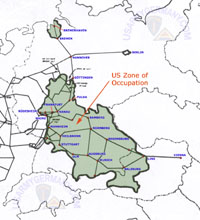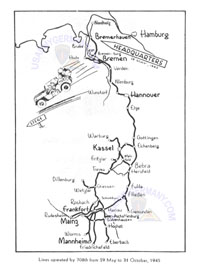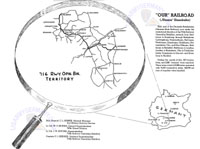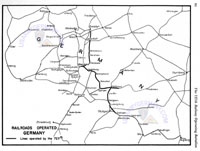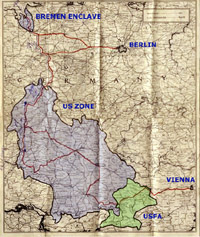If you do
NOT see the Table of Contents frame to the left of this page, then
Click here to open 'USArmyGermany'
frameset |
Transportation
in USFET & EUCOM 1940s
US Forces in the European Theater
Looking for more information from military/civilian
personnel assigned to or associated with the U.S. Army
in Germany from 1945 to 1989. If you have any
stories or thoughts on the subject, please contact me . .
|
|
|
|
|
|
| The
1940s |
|

Two military trains at the Karlsruhe train station, 1945 |
|
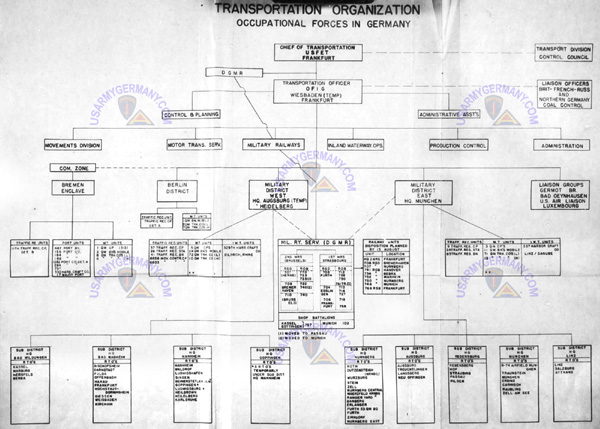
Office of Chief of Transportation, USFET, July 1945 (large format)
|
|
| 1946 |
| (Source: Chief of Transportation, Chapter XXXVI (Vol IV), The Second Year, OCCUPATION FORCES IN EUROPE Series) |
1. Mission.
Although the Office of the Chief of Transportation (OCT) withdrew still farther from the actual operation of German railroads, its primary mission -- the movement of men and materials on behalf of U.S. military forces in Europe -- remained unchanged in the second year of tha occupation. Reorganization of the European Theater, however, affected the range of the responsibilities of the Chief of Transportation, placing a larger share of operating tasks upon transportation staffs of military districts and posts. In its relations with the German Reichsbahn, OCT continued to follow the policy of placing maximum operational responsibility in German hands. The fulfillment of its mission, at least in regard to rail transportation, was therefore increasingly a matter of applying effective controls to a situation over which it had no first hand authority. Shipping to and from the European Theater remained under the control of the Chief of Transportation.
2. Organization as of 1 July 1946.
In the second year of the occupation opened on 1 July 1946, OCT was one of the special staff sections of the Commanding General, USFET. Headed by a Chief and Deputy Chief of Transportation, the office included six divisions, concerned with control and planning, administration, supply, marine operations, movements, and motor transport.
|
| |
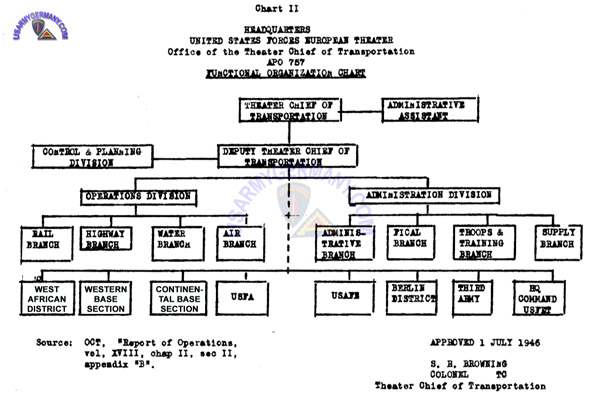
Office of Chief of Transportation, USFET, July 1946 |
| |
3. Reorganization.
Plans for reorganizing OCT were put into effect soon after 1 July 1946. Chart above shows the pattern on which the revised organization was based. In this revised structure the Control and Planning Division was continued; rail, highway, water, and air responsibilities were placed within at Operations Division; and the Administrative Division was reorganised to comprise Administration, Fiscal, Troops and Training, and Supply Branches. Modified only by the addition of a EUCOM Transportation Corps Center, and the substitution of the name Office Services Branch for Administrative Branch, this form of organization was continued through 30 June 1947.
4. Relationship within Headquarters.
Subsequent to the transfer of railroad operating responsibilities to Military Government and civil agencies on 1 January 1946, most of the functions of the Chief of Transportation were in the field of planning, coordination, supervision, and advice. As a member of the commanding general's special staff, the Chief of Transportation was responsibile for preparing plans, policies, and procedures on all transportation matters and for advising him on the assignment of key personnel and on the use of funds. Acting for the Assistant Chief of Staff, G-4, USFET, and subsequently for the Director of Supply, Services, and Procurement,
EUCOM, the Chief of Transportation was responsible for preparing programs to move Army supplies and personnel by land, air, and water. The Office also worked closely with G-1. To correct a situation in which first-class passengers waited an indefinite time at Bremerhaven for return to the United States, OCT developed a procedure for notifying G-1 of the number of spaces to be available on a specific date. These were assigned by G-1 to major commands, and passengers were sent forward accordingly.
5. Lower Echelons and Subordinate Units.
During the year there were changes in the major commands within the Theater, and in addition there were readjustments in the relations between the Chief of Transportation and the agencies or units responsible for specific tasks within the transportation mission. At the beginning of the period the major commands consisted of West African District; Western Base Section; Continental Base Section; U.S. Forces, Austria; U.S. Air Forces in Enrope; Berlin District; Third Army; and Headquarters Command, USFT. By the end of June 1947, the major commands were First and Second Military Districts; Berlin Military Command; Bremerhaven Port of Embarkation; American Graves Registration Command; U.S. Air Forces in Europe; U.S. Forces, Austria; and Headquarters Command, EUCOM. The relations of the Chief of Transportation both with major commands and with lower echelons were different for each type of transportation -- air, water, rail, and highway. A different pattern of organization existed for each of these, especially in the matter of units assigned to particular operational or supervisory tanks.
 a. Air Transportation. a. Air Transportation.
The Chief of Transportation, through the Air Branch of Operations Division, was responsible for processing requests for and for providing special air transportation. In order to meet the requirements of VIP (Very Important People) passengers, dependents destined for out-of-the-way places, and other special applicants for air transport, small pools of aircraft were maintained at key points throughout the Theater to fly special passenger missions.
 b. Rail Transportation. b. Rail Transportation.
With railway operating responsibility transferred to the German Reichsbahn, the task of the Chief of Transportation was one of arranging, rather than of providing, rail transportation for military movements. Throughout most of the year, District Transportation Offices and Rail Transportation Offices (RTO's) served as channels for requests to the Reichsbahn and for such technical supervision and control as was exercised by the Chief of Transportation. As of 15 March 1947, operation of freight RTO's was assumed by Reichsbahn personnel, passenger RTO's were taken over in the following weeks. Commanders of districts, posts, and service installations thereafter socured necessary rail transportation by direct arrangement between their transportation officers and local Reichsbahn personnel. The Chief of Transportation retained responsibility for negotiating with railroad agencies of other European countries to meet military requirements outside the occupied areaa. At the end of June, the only command authority of the Chief of Transportation was that exercised over fifty train commanders (known
after 1 May as "supervisors" and subsequently as "inspectors") assigned to the EUCOM Transportation Corps Center.
 c. Motor Transportation. c. Motor Transportation.
Until the discontinuance of Continental Base Section in May-June 1947, highway transportation was provided by truck companies and similar units assigned to Continental Base Section. Truck units were subseqnantly allocated to the First and Second Military Districts of the U.S. Zone. Only technical supervision was exercised over highway transportation by the Chief of Transportation.
 d. Water Transportation. d. Water Transportation.
The principal day-to-day activities of the Water Branch, Operations Division, concerned the operation of the Port of Bremerhaven. Inland waterways had small military significance, being useful only for the transport of cargoes of low value and so urgency, in situations where a complete haul could be accomplished without reloading. Although the ports in the United Kingdom and the liberated countries were no longer handling troops and military supplies, the Chief of Transportation supervised their use by the American Graves Registration Command.
6. The Field Organization.
In the reorganization of the European Theater as the European Command, it was provided that after 15 May the transportation field organization would consist of the Bremerhaven Port of Embarkation and of transportation sections and motor transport units assigned to major commands, military districts, technical service installations, and military posts. The EUCOM Transportation Corps Center, consisting of the 7795th Traffic Regulating Detachment, was established under the direct command of the Chief of Transportation to perform varied duties such as providing train supervisors, taking care of depots containing surplus property, and maintaining the British War Brides Office in London and an RTO in Poland.
7. Transportation Personnel.
a. Throughout the period 1 July 1946 to 20 June 1847, OCT retained the same officers in key positions, namely: Col. S. R. Browning, Chief of Transportation; Col. G. E. Wrockloff, Deputy Chief of Transportation; Col. R. C. Tripp, Chief of Operations Division; Col. H. H. Heumann, Chief of Control and Planning Division; Col. L. D. Bunting, Chief of Administration Division.
b. Until its close, Continental Base Section was the largest employer of transportation personnel in the Theater. As of 1 August 1946, the following units, with a total authorized strength of 647 officers, 16 warrant officers, 8,121 enlisted men, and 2,205 civilian truck company personnel, were assigned to Continental Base Section:
|
| |
1 Major Port (TC) |
17th Major Port, Bremerhaven |
| |
1 Port Battalion |
487th Port Bn, Bremerhaven |
| |
5 Port Companies |
|
| |
2 QM Groups, Truck |
476th QM Gp: 514th QM Gp |
| |
6 QM Battalions, Truck (1) |
4th QM Bn (514th); 6th QM Bn; 122nd QM Bn; |
| |
36 Truck Companies (Troop) (2) |
|
| |
15 Truck Companies (Heavy) |
|
| |
21 Civilian Truck Companies |
Technical Labor Service |
| |
2 Traffic Regulation Groups |
|
| |
1 Detachment Traffic Regulation Group |
|
| |
1 QM Car Platoon (3) |
|
| |
781st TC Base Depot Co (less Det "A") |
Karlsruhe |
|
780th TC Base Depot Co |
Bremerhaven |
|
|
|
|
(1) On 1 August 1946, the QM truck battalions were redesignated as Transportation Corps Truck Battalions in accordance with GO No 77, War Dept., 24 July 1946.
(2) 1 inoperative
(3) attached to the 514th QM Group |
| |
c. Although officer strength at the beginning of July 1946 was 60 percent of that authorized, arrivals during the next two months brought it up to 100 percent by the end of September. Units were generally overstrength in enlisted grades. Shipments to the United States up to the end of 1946 reduced Continental Base Section troop units to 85 percent of authorized officer strength and 90 percent of enlisted strength. In general, the loss of military personnel made the employment of additional civilians necessary during the fall and winter of 1946. At Berlin, transportation units were employing 2,728 civilians as of 1 October 1946. On 1 July 1946, civilian personnel in Continental Base Section units totaled 95 United States employees, 166 Allied and neutral, and approximately 21,000 Germans.
8. Procedures Governing Military Movements.
Rail movements throughout this period were governed by SOP 67. This directive required the monthly submission by using agencies of estimated transportation needs, and established a release system to insure maximum use of rolling stock within the U. S. Zone. a. Part One of SOP 67 governed the personnel and supply movement program for Germany. Responsibility for screening military movement requirements was placed on the Chief of Transportation, who accordingly prepared monthly movement estimates for submission to OMGUS, the agency charged with direct responsibility for Reichsbahn operations. In practice, Military Government rail officials used these military estimates to ascertain the approximate number of freight cars that would be left over for civilian freight movements during the coming month.
b. Part Two set forth procedures in the release, reception,
outloading, and movement of military personnel and supplies in both liberated and occupied countries. It directed military users of transportation to submit their requirements monthly to the Chief of Transportation. Estimates were to cover tonnages to be moved from liberated countries to Germany, Bremen to U.S. Zone and Berlin, and depots to ports, as well as movements within a single base section and into Austria. After review and consolidation, these requirements were to be forwarded to Movements Branch. Transport Division, OMCUS (Rear), on the 19th of each month.
c. The Chief of Transportation was not concerned with the methods employed by OMGUS and the Reichsbahn to supply cars for military needs. Since military traffic carried top priorities, military requests for rail care were met by station masters without delay. Remaining cars were used in filling civil needs under a priority system established by OMGUS. At the end of June 1947, only 5 percent of available freight cars were being used in military movements.
9. Movement Program Estimates.
Estimates of rail movements were assembled for planning purposes in the monthly personnel and supply movement programs prepared by OCT. On the other hand, OCT did not receive detailed reports on actual mowements.
10. Transportation Release System.
SOP 67 also set up a procedure designed to cut down the time during which rail care were detained by Army shippers, so that more cars would be continually available for the civilian economy. All shipments of military supplies, were required to have a Transportation Corps Release (TOR) Number before being loaded or released to the railroads for movement. The chiefs of services of CBS, WBS, USFA, and USAFE were made responsible for limiting the dispatch of supplies to the terms of approved TCR's. At Theater level, the chiefs of services and the Assistant Chiefs of Staff, G-1 and G-3, were made responsible for coordinating the requirements of their corresponding staffs in the major commands.
The Chief of Transportation was directed to submit movement estimates to OMGUS, assign ships to ports as required by the movement program, operate a Movements Control Office, and issue the necessary technical instructions to supplement the release system. The outstanding purpose of the system was to require clearance of all military freight shipments through the Office of the Chief of Transportation, so that the quantity, rate, and time of every shipment would be subject to centralized control.
11. Issuance of Transportation Corps Releases.
The TOR system went into effect on 1 August 1946, and the following weeks witnessed a persistent drive by OCT to have it enforced,
especially through the chiefs of services. From October to June, releases were issued for the movement of rail cars as follows:
|
|
MONTH |
|
TCR's |
|
No. of Cars |
|
|
|
Oct |
|
3,261 |
|
64,539 |
|
|
|
Nov |
|
4,037 |
|
59,143 |
|
|
|
Dec |
|
4,109 |
|
53,953 |
|
|
|
|
Total |
11,407 |
|
177,635 |
|
|
|
|
|
|
|
|
|
|
|
Jan |
|
5,054 |
|
49,555 |
|
|
|
Feb |
|
4,924 |
|
64,014 |
|
|
|
Mar |
|
5,883 |
|
52,410 |
|
|
|
|
Total |
15,861 |
|
165,979 |
|
|
|
|
|
|
|
|
|
|
|
Apr |
|
5,589 |
|
42,167 |
|
|
|
May |
|
4,393 |
|
38,625 |
|
|
|
Jun |
|
4,757 |
|
46,216 |
|
|
| |
|
Total |
14,739 |
|
127,008 |
|
|
|
| |
12. Rail Passengers.
Until the late spring of 1947, the movement of rail passengers
was facilitated by the existence of RTO's at the principal stations in Germany and the liberated countries. During April and May, RTO operations were transferred to the Reichsbahn in Germany and discontinued within the liberated countries. For some time thereafter, rail passenger traffic was supervised by military supervisory teams and a small group of train commanders. In addition to leave and duty passengers within the Theater, replacements and redeployed troops using the port of Bremerhaven accounted for a large share of rail travel. War brides and dependents also created special demands on rail passenger service.
 a. Daily Passenger Averages. a. Daily Passenger Averages.
From October 1946 to June 1947 the railroads carried daily averages of 1,381 passengers on military duty trains and 703 passengers on redeployment sets ("red sets"). Figured by the month, the daily averages were as follows:
|
|
Year |
Month |
Daily Average Number of Passengers |
| |
|
|
|
| |
|
|
Military Duty Trains |
Red Sets |
|
|
|
1946 |
Oct |
1,089 |
1,048 |
|
| |
|
Nov |
981 |
1,123 |
|
| |
|
Dec |
883 |
1,247 |
|
| |
1947 |
Jan |
1,489 |
777 |
|
| |
|
Feb |
1,322 |
715 |
|
| |
|
Mar |
1,820 |
504 |
|
| |
|
Apr |
1,639 |
320 |
|
| |
|
May |
1,788 |
342 |
|
| |
|
Jun |
1,423 |
251 |
|
|
|
| |
 b. Types of Passengers. b. Types of Passengers.
Totals by categories of rail passengers carried during July, August, and September 1946, as reported by Continental Base Section, are shown below: |
| |
US Military Personnel, including
duty, leave, and redeployed |
334,601 |
|
| |
Allied Military personnel |
14,269 |
|
| |
US Civilians |
1,625 |
|
| |
UNRRA |
670 |
|
| |
German civilians employed by US
or authorized to travel
|
5,754 |
|
| |
Displaced persons |
313,366 |
|
| |
Prisoners of war |
79,603 |
|
| |
Others |
3,559 |
|
|
| |
13. Port Operations.
 a. Cargo and Passenger Traffic. a. Cargo and Passenger Traffic.
Cargo and personnel handled by military ports in the European Theater were as follows: |
|
Month
1946
|
Long Tons
Discharged |
|
Long Tons
Outloaded |
|
Personnel
Embarked |
|
Personnel
Debarked |
|
| |
Jul |
126,454 |
|
72,714 |
|
39,765 |
|
18,354 |
|
| |
Aug |
146,564 |
|
70,200 |
|
19,141 |
|
9,835 |
|
| |
Sep |
147,870 |
|
71,689 |
|
18,821 |
|
11,695 |
|
| |
Oct |
177,540 |
|
52,578 |
|
38,010 |
|
8,780 |
|
| |
Nov |
215,487 |
|
33,069 |
|
31,386 |
|
7,085 |
|
| |
Dec |
171,440 |
|
48,603 |
|
30,449 |
|
5,108 |
|
| |
|
|
|
|
|
|
|
|
|
| |
1947 |
|
|
|
|
|
|
|
|
| |
Jan |
211,972 |
|
23,727 |
|
26,960 |
|
8,314 |
|
| |
Feb |
107,696 |
|
9,542 |
|
18,302 |
|
5,220 |
|
| |
Mar |
116,468 |
|
20,128 |
|
15,287 |
|
7,880 |
|
| |
Apr |
104,328 |
|
15,927 |
|
13,376 |
|
6,038 |
|
| |
May |
118,885 |
|
19,662 |
|
12,506 |
|
2,117 |
|
| |
Jun |
105,553 |
|
19,313 |
|
10,310 |
|
3,889 |
|
| |
TOTAL |
1,708,258 |
|
453,697 |
|
274,313 |
|
94,315 |
|
|
| |
| Cargo was discharged at the ports of Bremerhaven and Bremen during June 1947 as follows (in long tons): |
| |
QM |
17,325 |
|
TC |
48 |
|
|
| |
Refrigerator |
4,180 |
|
AAF |
389 |
|
|
| |
Vehicles |
744 |
|
Med |
367 |
|
|
| |
Ordnance |
1,554 |
|
POL |
70,852 |
|
|
| |
Engr |
496 |
|
Misc |
353 |
|
|
| |
EES |
7,928 |
|
Mail |
900 |
|
|
| |
Sig |
39 |
|
Household Goods |
346 |
|
|
|
| |
 b. Western Ports. b. Western Ports.
On 9 July 1946, with the sailing of the Sea Flyer, Le Havre ceased to operate as a redeployment port and Bremerhaven became the sole port on the Continent for the handling of U.S. military personnel. During July, Marine Operations Division, Western Base Section, off-loaded a total of ninety-eight ships and coasters carrying 608 tons and 20,955 passengers. Forty-two ships sailed from Western Base ports carrying 13,889 passengers and 67,836 tons of cargo. Seven troop ships carrying 1,076 passengers sailed from Southampton during 1946. During August 1946, Western Base Section ports handled the following movements of personnel and cargo: |
|
Port |
Tons In |
|
Tons Out |
|
Personnel In |
|
Personnel Out |
|
| |
Le Havre |
0 |
|
2,088 |
|
1,450 |
|
0 |
|
| |
Southampton |
0 |
|
0 |
|
19 |
|
1,504 |
|
| |
Marseille |
15,190 |
|
10,126 |
|
0 |
|
0 |
|
| |
Antwerp |
19,686 |
|
20,632 |
|
0 |
|
3 |
|
| |
TOTAL |
34,876 |
|
32,846 |
|
1,469 |
|
1,507 |
|
|
| |
| On 22 November Marseille closed down with the sailing of the Army Transport Linksplice. Activities during November were as follows: |
|
Port |
Tons In |
|
Tons Out |
|
Personnel In |
|
Personnel Out |
|
| |
Antwerp |
0 |
|
0 |
|
0 |
|
0 |
|
| |
Marseille |
0 |
|
9,959 |
|
0 |
|
0 |
|
| |
Dover |
0 |
|
894 |
|
115 |
|
0 |
|
| |
TOTAL |
0 |
|
10,853 |
|
115 |
|
0 |
|
|
| |
During December there was no shipping activity by OCT in either French or Belgian ports.
 c. Operations at Bremerhaven. c. Operations at Bremerhaven.
By July 1946 the port of Bremerhaven was serving as the main funnel for United States military cargo and passengers entering and leaving Germany. The Water Branch, Operations Division, OCT, supervised the discharge and out-loading operations of the port, obtained shipping space to meet requirements, and maintained records on incoming ships.
Ship arrivals and sailings and cargo discharged at Bremerhaven, including Bremen, during July 1946 were as follows: |
| |
US Army cargo discharged at Bremerhaven |
31,327 tons |
|
| |
Daily average discharged at Bremerhaven |
1,205 tons |
|
| |
Percent of total US Army cargo discharged |
15.2 % |
|
| |
|
|
|
| |
Other than US Army cargo (miscellaneous, mail, baggage, personal
vehicles, Civil Affairs I) discharged at Bremerhaven
|
4,856 tons |
|
| |
Daile average discharged at Bremerhaven |
18.7 tons |
|
| |
Percent of total cargo other than US Army |
2.3 % |
|
| |
|
|
|
| |
Bulk POL discharged at Bremerhaven |
89,964 tons |
|
| |
Daily average discharged at Bremerhaven |
3,460 tons |
|
| |
Percent of total bulk POL discharged |
43.4 % |
|
| |
|
|
|
| |
Civil Affairs I Grain discharged at Bremerhaven |
79,399 tons |
|
| |
Daily average discharged at Bremerhaven |
5,054 tons |
|
| |
Percent of total Civil Affairs I Grain discharged |
38.1 % |
|
| |
|
|
|
|
Daily average number of in-bound cargo ships on berth
at Bremerhaven |
3 |
|
| |
|
|
|
|
Daily average number of out-bound cargo ships on berth
at Bremerhaven |
4 |
|
| |
|
|
|
|
Daily average number of troop and dependents ships, either
for out-loading or for discharging |
3 |
|
| |
|
|
|
|
Number of arrivals of troop and dependents carriers |
21 |
|
| |
|
|
|
|
Number of sailings of troop and dependents carriers |
18 |
|
|
| |
 d. Civil Relief Supplies. d. Civil Relief Supplies.
During January 1947, twenty-nine vessels chartered by the Transportation Corps transported 195,000 long tons of grain and 66,000 long tons of flour to the U.S. Zone of Germany. Extremely cold weather variously interfered with cargo operations at Bremen and Bremerhaven during the winter months, while scarcity of labor and the shortage of rail cars added further handicaps. A total of 324,000 tons of civil relief supplies was programmed for shipment to Austria during the first six months of 1947.
 e. Transportation of War Brides. e. Transportation of War Brides.
Transportation of European war brides to the United States continued to be an important activity of the Transportation Corps. By 21 September 1946, a total of 48,029 had been shipped to the United States, including 41,403 from England, 4,705 from France, and 1,581 from Belgium. At the end of September, more than 14,000 awaited shipment.
The ports of La Havre and Southampton made their final shipments of war brides on 28 July and 18 October, respectively. The shipment
of war brides through Bremerhaven began with the sailing of the President Tyler at the end of August. During the first quarter of 1947, 1,067 war brides were embarked for the United States. As of 15 March, a total of 55,529 brides had been shipped. During the second quarter of 1947, war-bride shipments reported to OCT totaled 235 children and 398 adults in April, 236 children and 644 adults in May, and 171 children and 471 adults in June.
 f. Transportation of Dependents. f. Transportation of Dependents.
In the third quarter of 1946, 6,230 dependents arrived at Bremerhaven, three times the number arriving at the port in the preceding quarter. During the fourth quarter, 5,120 dependents arrived by ship. A peak number, 3,861, reached the European Theater in November, through all channels. Total arrivals by ship were 1,246 in the first quarter of 1947, and 2,761 in the second quarter.
14. Highway Transport.
The principal problems encountered in the operation of motor transport were the lack of adequate ordnance support and a shortage of trained personnel. In spite of these handicaps, motor tranportation played an impressive part in Operation SPUD and Operation SPLINTER, the Army programs for hauling German harvest crops and wood for German fuel.
 a. Theater-Wide Figures. a. Theater-Wide Figures.
As of 1 July 1946, motor transport units were allocated to base sections and other headquarters as follows: |
|
|
Groups |
Battalions |
Companies
Light
(1) |
Companies
Heavy (1) |
Tech.
Labor Sv
|
Car
Companies |
Car
Platoons |
|
| |
CBS |
2 |
9 |
39 |
14 |
42 |
|
6 |
|
| |
Berlin Dist |
|
1 |
2 |
1 |
10 |
2 |
|
|
| |
USFA |
|
|
1 |
1 |
1 |
1 |
|
|
| |
USFET |
|
|
1 |
1 |
4 |
2 |
|
|
| |
WBS |
|
|
4 |
1 |
49 |
|
1 |
|
| |
TOTAL |
2 |
10 |
47 |
18 |
106 |
5 |
7 |
|
|
| |
(1) Not included in the table are seven Technical Labor Subervision Companies assigned to the American Graves Regirstration Command.
As of June 1947, motor transport units were assigned as follows:
|
| |
Number of Companies |
Installation or Headquarters |
|
| |
6 |
|
5 |
|
11 |
|
1 |
|
2 |
|
5 |
|
6 |
|
12 |
|
11 |
|
34 |
|
29 |
|
|
1st Military District |
|
2nd Military District |
|
QM Depots |
|
Engineer Depot |
|
USFA |
|
Bremerhaven POE |
|
AGRC |
|
OMGUS |
|
Hq Command, Frankfurt |
|
1st Military Dist. Posts |
|
2nd Military Dist. Posts |
|
|
|
|
| |
 b. Operations for 1946. b. Operations for 1946.
Motor transport operations for the year ending 31 December 1946 are summarized below: |
| |
Average no. of companies operative |
112.3 |
|
| |
Average no. of 2½-ton equivalent companies |
148.3 |
|
| |
Average no. of vehicles assigned per company |
51.0 |
|
| |
Average no. of vehicles available per company |
33.9 |
|
| |
Average daily tons hauled per company |
213.8 |
|
| |
Average daily tons hauled per vehicle |
6.3 |
|
| |
Average daily trips per vehicle |
2.1 |
|
| |
Average daily tons per vehicle trip |
3.1 |
|
| |
Average distance forward per vehicle trip |
9.8 |
|
|
| |
 c. Western Base Section. c. Western Base Section.
Motor transport operations diminished markedly is WBS throughout the second half of 1946. On 30 June 1946 there were thirty-eight truck companies operating in the Section. This number was reduced to thirty-six as of 31 July, twenty-five on 31 August, and twenty on 30
September. Operations during the second half of 1946 may be summarized as follows: |
|
1946 |
Tonnage
Hauled
|
|
Personnel
Hauled
|
|
Miles
Traveled
|
|
|
| |
3rd Quarter |
502,805 |
|
521,115 |
|
4,484,187 |
|
|
| |
4th Quarter |
124,805 |
|
134,943 |
|
1,325,248 |
|
|
|
| |
 d. Continental Base Section. d. Continental Base Section.
At the beginning of October, seventy-four truck companies were assigned to CBS. By the end of 1946, approximately 1,150 German drivers were being employed in these units. Motor transport units assigned to CBS on 1 February 1947 were as follows: 1 group, 6 battalions, 19 light-truck companies, 24 technical labor service companies, and 1 car platoon. Effective 15 April 1947, the following units were transferred to Bremerhaven Port of Embarkation: |
| |
Hq & Hq Det 3rd TC Truck Bn w/Med |
|
|
| |
Det "A" 9th Traffic Regulation Group |
|
|
| |
Det "A" 11th Traffic Regulation Group |
|
|
| |
1001 TC Warehouse Team |
|
|
| |
3396 TC Truck Company |
|
|
| |
3424 TC Truck Company |
|
|
| |
3493 TC Truck Company |
|
|
| |
3985 TC Truck Company |
|
|
| |
4002 TC Truck Company |
|
|
| |
4007 TC Truck Company |
|
|
| |
4224 TC Car Company |
|
|
|
| |
19. Air Transport.
It was the function of OCT to establish policies oontroling special air lift for both personnel and cargo within the European Theater. This involved the screening of high priority passenger and cargo requests in the light of availability of scheduled aircraft and necessity
for air travel or delivery. Rules governing individual air travel on military air lines in the European Theater were clarified by USFET
Circular No. 120, published 28 August 1946.
 a. Aircraft Pool System. a. Aircraft Pool System.
On 1 November 1946, aircraft previously assigned to offices or headquarters were withdrawn and a system of aircraft pools was established for the Theater. These pools established as shown below, began functioning in November.
|
|
Location
of Pool
|
Controlling
Command |
|
Major Commands or Agen-
cies Entitled to Service |
|
No. & Type
of Aircraft |
|
|
| |
Frankfurt |
Hq, USFET, OCT |
|
Hq, USFET |
|
1 - C54
7 - C47
|
|
|
| |
|
|
|
Hq, 3rd US Army |
|
2 - C45 |
|
|
| |
|
|
|
Hq, CBS |
|
--------- |
|
|
| |
|
|
|
US Constabulary |
|
--------- |
|
|
| |
Paris |
Hq, WBS |
|
Hq, WBS |
|
1 - C47 |
|
|
| |
|
|
|
OFLC (1) |
|
--------- |
|
|
| |
|
|
|
AGRC |
|
--------- |
|
|
| |
Berlin |
Hq, OMGUS |
|
Hq, OMGUS |
|
1 - B17
2 - C47 (C117)
|
|
|
| |
Vienna |
Hq, USFA |
|
Hq, USFA |
|
1 - B17
2 - C27
|
|
|
| |
Nürnberg |
OUSCC (2) |
|
OUSCC |
|
1 - C47
1 - L5
|
|
|
|
(1) OFLC . . . Office of the Foreign Liquidation Commisioner
(2) OUSCC . . . Office of the US Chief Counsel (for the Prosecution of Axis Criminality)
 b. Missions Flown. b. Missions Flown.
Flights handled during the year were as shown below: |
|
Type of Flight |
3rd Qu. 46 |
|
4th Qu. 46 |
|
1st Qu. 46 |
|
2nd Qu. 46 |
|
| |
VIP |
52 |
|
36 |
|
63 |
|
96 |
|
| |
Evacuations |
37 |
|
24 |
|
9 |
|
11 |
|
| |
Cargo |
26 |
|
13 |
|
7 |
|
6 |
|
| |
Routine |
22 |
|
5 |
|
0 |
|
0 |
|
| |
Special |
0 |
|
7 |
|
26 |
|
34 |
|
| |
Revenue |
4 |
|
0 |
|
0 |
|
0 |
|
| |
TOTAL |
153 |
|
83 |
|
82 |
|
147 |
|
|
| |
 c. Movement of Dependents. c. Movement of Dependents.
In Operation REUNION, 800 dependents were flown to the Theater during the closing months of 1946.
20. German Harvest and Fuel Program.
One of the more striking accomplishments of the Transportation
Corps was the assistance given to OMGUS in hauling farm products and fuel
wood. The German harvest program, known as Operation SPUD, was in effect from 31 October 1946 to 1 January 1947. By direction of the Theater Commander, forty-six military communities made 20 percent of their trucks available for use within a 50-mile radius. In addition, thirty-one organized truck companies participated in the program. A total of 4,500,000 cubic meters of cord wood was delivered to cities throughout the zone,
and 80,000 tons of potatoes were moved by Army trucks. At the end of forty-nine working days of operations, 136,046 tons had been hauled, and trucks engaged in the program had driven a total of 1,131,228 miles.
21. Summary of Problems.
OCT had to overcome many obstacles in accomplishing its mission for the year 1946-47. In the field of rail transportation, problems centered about the lack of skilled German personnel and the shortage of refrigerator cars, passenger coaches, sleeping cars, and locomotives. Motor transport suffered from a loss of trained personnel, shortage of officers, and inadequate maintenance support. The main problem in water transport was a shortage of shipping space, particularly of first-class passenger space. In line with the current policy of assisting the German economy, OCT endeavored to aid the development of transportation. The major problem encountered in this field was that of maintaining the inadequate German equipment.
|
 |
|
|
| Military Railway Service |
| |
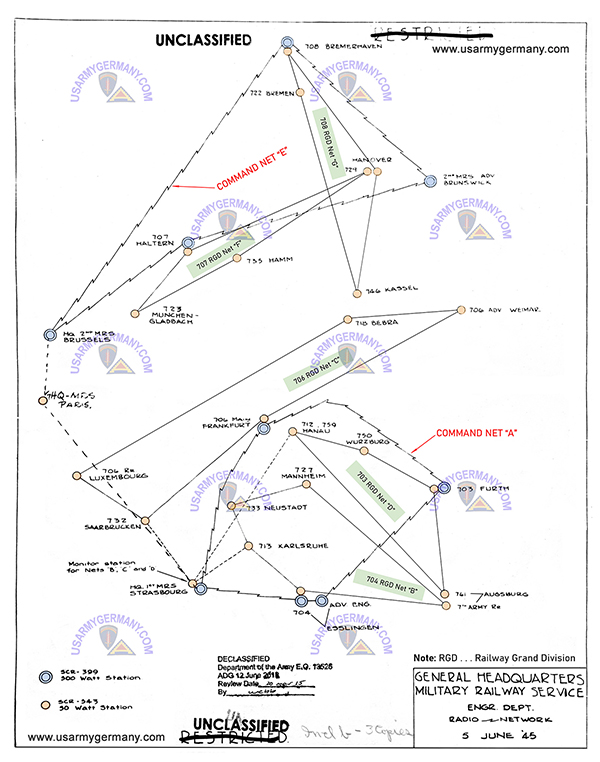
Radio Network, GHQ, Military Railway Service, June 1945 (Webmaster's collection)
(click on image for enhanced view) |
|
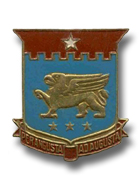 2nd Military Railway Service DI 2nd Military Railway Service DI |
| |
| 1945 |
(Source: Transportation. OCCUPATION FORCES IN EUROPE SERIES ) |
On Feb 6 1945, the two existing Military Railway Services (1st and 2nd), which had operated independently, were consolidated and a provisional headquarters was established in PARIS (GO#16, ComZ). A director general was appointed to control of all railway operating units. These functions were further defined and somewhat modified, insofar as the command responsibilities were concerned, on April 3 1945 (SOP#32, ETOUSA, subj: "Continental Railways"). The Dir Gen, MRS, was then made responsible for the maintenance of way and equipment and for the operation of railroads on the Continent.
The Military Railway Service became an exempted command, responsible to Chief of Transportation, except that the sections of the ComZ had admin authority over the MRS general courts martial, financial transactions, and the issue of ordinary supplies. All MRS units, together with some MP units to act as security guards, were assigned to GHQ, MRS, which in turn reassigned them to the 1st and 2nd Military Railway Service for operations.
One of the first acts of the new hqs was to divide the operating territory between the two rail organizations. Boundaries were established on April 6, but the fast pace of the last weeks of the campaign necessitated changes. The areas in effect on V-E Day were roughly north and east of PARIS for the 2nd MRS, and south and west of PARIS for the 1st MRS.
Shortly before the end of the campaign, the 2nd MRS Hqs at BRUSSELS established an advance echelon at BRAUNSCHWEIG.
Operating Units
The operating unit of the MRS was a Railway Grand Division, usually placed so that its jurisdiction coincided with that of a base section. Instead of having a fixed Table of Organization, these divisions were allocated troops on the basis of the track mileage they operated. With the usual assignment of
 three Railway Operating Battalions (ROB) three Railway Operating Battalions (ROB)
 one Railway Shop Battalion (RSB) one Railway Shop Battalion (RSB)
 one Base Depot Co one Base Depot Co
A Grand Division was normally able to perform Phase I operations over 250 to 400 miles.
MRS after V-E Day
On May 19 1945, MRS was established as a separate service command under the CG, ComZ. Technical control remained with the Chief of Trans, ComZ, operation and admin control passed, with certain exceptions, to GHQ, MRS, ComZ (Prov), which had been previously organized. ( Cir 70, ComZ, 19 May 45)
Adv Sec, GHQ, MRS was established in FRANKFURT on June 4, 1945 ( GO#26, MRS (Prov), 4 Jun 45). The duties of the rear echelon were passed from the 1st MRS to the Paris Prov RGD, organized on June 1 1945 ( GO#24, MRS (Prov), 31 May 45).
When HQ ComZ was redes HQ TSFET on Aug 1, MRS, was renamed as U.S. Theater MRS, and was established as a tech comd under the CG, TSFET ( GO#179, HQ USFET, 2 Aug 45).
Hqs of 2nd MRS in BRUSSELS closed on Aug 11 and opened the next day in FRANKFURT. Effective Aug 15, a new territorial division was made between the 1st and 2nd MRS (1):
| |
1st MRS |
AOR: France, Luxembourg |
| |
 Paris Prov MRS Paris Prov MRS |
Paris, France |
| |
2nd MRS (2) |
AOR: Germany, Austria, Italy |
| |
 707th RGD 707th RGD |
Nürnberg, Bavaria |
| |
 708th RGD 708th RGD |
Bremerhaven, Bremen Enclave |
| |
Belgian District |
AOR: Belgium, the Netherlands |
| |
 706th RGD 706th RGD |
|
| |
|
|
(1) Listing of RGD units might be incomplete. Still doing some research on this.
With the reorganization on Aug 15, 1945, the railway operating battalions in Germany under the 2nd MRS were supposed to be:
| |
2nd MRS (2) |
Frankfurt, Germany |
|
| |
 707th RGD 707th RGD |
Nürnberg, Germany |
|
| |
 712th ROB (3) 712th ROB (3) |
Mannheim, Germany |
inact Dec 9, 1945 |
| |
 750th ROB 750th ROB |
Nuernberg, Germany |
inact Feb 10, 1946 |
| |
 746th ROB 746th ROB |
Munich, Germany |
inact Feb 10, 1946 |
| |
 708th RGD 708th RGD |
Bremerhaven, Germany |
|
| |
 741st ROB 741st ROB |
Hannover, Germany |
inact Feb 10, 1946 |
| |
 734th ROB 734th ROB |
Bebra, Germany |
inact Feb 10, 1946 |
| |
 766th RSB 766th RSB |
Frankfurt, Germany |
|
| |
|
|
|
(2) Currently doing some research to find out if the "planned" organization was actually implemented. In previous research I have found quite a few additional ROB and RSB units that served in the ETO until the end of 1945 or early 1946. However, many of those were probably located in France and involved with the Redeployment efforts around several ports of France (Le Havre and Marseille).
(3) Based on a poor quality photo copy of the organization chart of the Office of the Chief of Transportation, COMZ (Jul-Sep 1945). Could not make out if the battalion listed was the 712th or 722nd ROB)
|
|
Main US Rail Lines in
Germany and Austria |
|
Also on Aug 15, the Belgian District of MRS was established, which included Belgium and the Netherlands. The district was placed under the jurisdiction of the Commanding Officer, 706th RGD, who reported directly to the Dir Gen, MRS.
In an agreement with the British opening the rail line of communications from BREMERHAVEN, US traffic was allocated by the joint Traffic Allocation Committee with the first priority to movement of American personnel and supplies. The line was operated by Germans under American supervision and control. General operating policy was fixed by the British Regional Railway Control Team, which included American representatives.
|
|
It was not until Oct that some admin responsibilities were turned over to the German Reichsbahn authorities. On Oct 24 45, GHQ, MRS was officially closed ( GO#59, HQ TSFET, 24 Oct 45). Shortly thereafter, 1st MRS was assigned supervisory responsibility for all US military railway matters and interests in the liberated areas. and 2nd MRS assumed supervisory control of German railway ops in the zone of occupation. Both services were closed when responsibility for railway supervision passed to the Trans Div of the US Military Gov't on Jan 1 1946.
Rail operations in Austria
Rail ops in Austria were in Phase III (rail operations turned over to Austrians) by Sep 1945. Control of Austrian transport was vested in the Trans Div, US Allied Commission for Austria. |
|
| |
| (Source: Military Railway Service, The General Board Study No. 123) |
The basic operating unit in the ETO was the Railway Operating Battalion consisting of four companies:
 HHC in charge of administration, train dispatching, supply, communications, and signals; HHC in charge of administration, train dispatching, supply, communications, and signals;
 Co A responsible for maintenance of way and strcutures; Co A responsible for maintenance of way and strcutures;
 Co B operated the engine house and made running repairs of motive power and rolling stock; Co B operated the engine house and made running repairs of motive power and rolling stock;
 Co C was the actual operating unit, with 50 train and engine crews. Co C was the actual operating unit, with 50 train and engine crews.
This basic operating unit was capable of operating 90 to 150 miles of track with not more than one terminal with classification yard facilities. The Bn consisted of 29 officers and 790 EMs.
The Railway Shop Battalion was responsible for maintaining and repairing rolling stock, and was equipped to serve from three to four ROBs.
|
|
| |
| 708th Railway Grand Division |
| (Source: The Saga of the 708 Railway Grand Division, by MAJ A.G. Gregory, 1947) |
|
708th RGD AOR |
|
Map showing area of responsibility for the 708th Railway Grand Division between May and Oct 1945.
After VE-Day, the 708th Railway Grand Division (RGD) was sent to Bremerhaven to establish headquarters and supervise the rail operations at the only German port to be used by the Americans in the German occupation. In addition, the 708th was tasked with supervising the operation and maintenance of the railway line of comunications leading from the port of Bremerhaven to the US Army of Occupation located in southern Germany, in the US Zone of Occupation. (The Port of Bremerhaven and the City of Bremen were designated as an American Zone - called the Bremen Enclave.)
|
|
The 708th set up headquarters at Wesermünde (twin city of Bremerhaven) on May 21, in a six-story building that previously had been a German bank and insurance office. Two railway operating battalions and one railway shop battalion were assigned to the 708th at that time.
The 722nd ROB was located at Bremen (just to the south of Bremerhaven); the 746th ROB was at Kassel. The 757th RSB took over the Henschel and Sons Locomotive Works in Kassel and set up shop there.
Once the redeployment program became active, a reorganization of the 708th occurred with the following battalions joing the Grand Division: the 741st ROB was moved to Hannover; the 734th ROB was moved to Kassel (replacing the 746th ROB?); the 759th ROB was located at Kleinauheim (near Hanau); the 766th RSB was located at Frankfurt. (The 722nd staid in Bremen; not sure if the 757th RSB was still in Kassel.)
The railways in the AOR of the 708th were operated by "area control," with the northern sector operating under the office known as the Hannover Reichsbahndirektion and the southern sector under the Kassel Reichsbahndirektion. Both offices operated under the direction of the Military Railway Service. Full German crews were used. ROB personnel were used for supervisory and guard purposes only. |
|
| |
716th Railway Operating Battalion
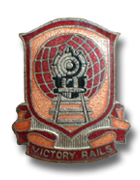 716th Railway Operating Battalion DI 716th Railway Operating Battalion DI
|
| |
|
|
| |
727th Railway Operating Battalion
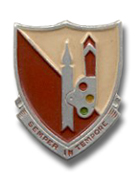 727th Railway Operating Battalion DI 727th Railway Operating Battalion DI
|
| |
| (Source: The 727th Railway Operating Battalion in World War II, Simmons-Boardman Publ. Corp., 1948) |
|
Battalion AOR |
|
Map showing area of responsibility for the 727th Railway Operating Battalion in the May to July 1945 timeframe. |
|
|
| |
| 1946 |
| (Source: WELCOME TO EUROPE pamphlet, 1946, issued to new arrivals in Europe -- modified by webmaster) |
|
| |
| Effective 1 August 1946, the Quartermaster Corps transferred the functions and responsibilities of truck and aviation units to the Transportation Corps completing the transition of responsibility for management of all transportation. |
|
|
| The Yankee Boomer - Some of the issues published while in Germany |
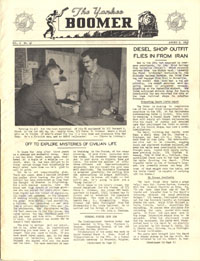 9 Aug 1945, Page 1
9 Aug 1945, Page 1 |
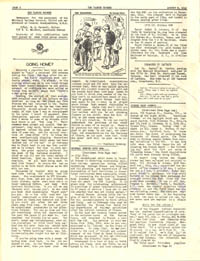
9 Aug 1945, Page 2
|

9 Aug 1945, Page 6
|
|
| |
| The 716th High-Ball - Some of the issues published while in Germany |
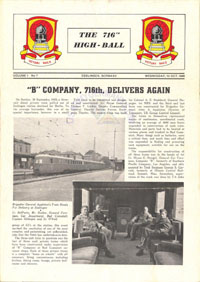 10 Oct 1945, Page 1
10 Oct 1945, Page 1 |
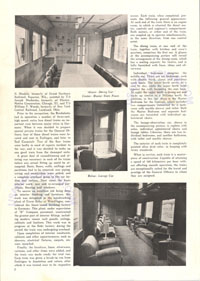
10 Oct 1945, Page 2
|
|
 |
|
| |
Related Links:
|
| |
| |
|
 2nd Military Railway Service DI
2nd Military Railway Service DI 716th Railway Operating Battalion DI
716th Railway Operating Battalion DI  727th Railway Operating Battalion DI
727th Railway Operating Battalion DI 




